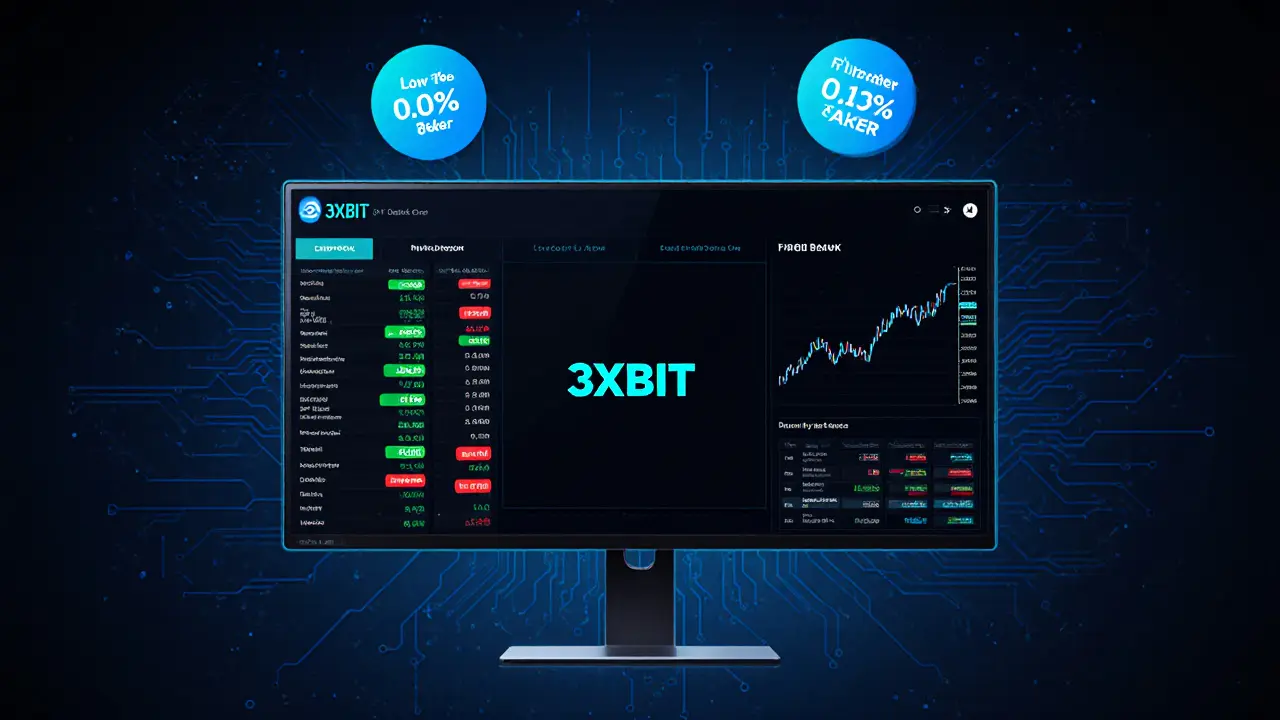3XBIT Fee Calculator
Calculate Your Trade Costs
Estimate fees for spot and derivatives trading on 3XBIT compared to major competitors.
If you’ve typed 3XBIT crypto exchange review into Google, you’re probably hunting for a clear picture of what the platform actually offers. The reality is that 3XBIT isn’t as widely covered as giants like Binance or Bybit, which makes gathering reliable data a bit of a scavenger hunt. In this article we’ll unpack everything we can find, point out the gaps, and give you a practical framework to decide whether 3XBIT fits your trading style.
What is 3XBIT?
3XBIT is a cryptocurrency exchange that positions itself as a low‑fee, high‑liquidity platform for both spot and derivatives trading. The service launched in early 2023 and claims to serve a global user base, though precise registration numbers are not publicly disclosed.
Regulatory Landscape
Regulation is a make‑or‑break factor for any exchange. 3XBIT states that it operates under the jurisdiction of the Seychelles Financial Services Authority, a common choice for emerging crypto platforms. This licensing provides a basic compliance framework but falls short of the stricter oversight seen in the EU’s MiCA or the U.S. FinCEN regime. Traders should verify that the exchange’s KYC/AML procedures match the level of scrutiny required in their country.
Security Measures
Security measures are critical. 3XBIT advertises cold‑storage of the majority of user funds, multi‑factor authentication (MFA), and regular third‑party penetration testing. However, there are no publicly available audit reports or certifications (e.g., SOC2) that can be inspected. Compared with exchanges that publish detailed security whitepapers, the lack of transparent documentation is a red flag that warrants extra caution.
Fee Structure
The fee structure on 3XBIT follows a maker‑taker model. Makers pay 0.08% per trade while takers incur 0.12%. There are no deposit fees for fiat top‑ups, but withdrawal fees vary by cryptocurrency and can be higher than average on less‑liquid assets. For high‑frequency traders, the spread between maker and taker rates can affect profitability, so it’s worth running a quick cost calculator on your typical trade size.

Supported Cryptocurrencies and Products
At the time of writing, 3XBIT lists over 120 trading pairs, covering major coins like Bitcoin (BTC), Ethereum (ETH), and stablecoins such as USDT. The platform also offers perpetual futures on a subset of these assets, with leverage options up to 10×. While the token selection is respectable, niche altcoins and emerging DeFi tokens are missing, limiting diversification for adventurous traders.
User Interface & Experience
The user interface is web‑based with a responsive design that adapts to mobile browsers. New users will see a clean dashboard showing balances, recent trades, and a quick‑order panel. Advanced users can switch to a “pro” layout that adds depth charts, order‑book heat maps, and API key management. Feedback from community forums points to occasional latency spikes during peak market hours, a common issue for platforms with moderate liquidity.
Liquidity and Trading Volume
Liquidity directly influences slippage. Publicly reported 24‑hour volume for 3XBIT hovers around $30million, considerably lower than the multi‑billion volumes on established exchanges. Lower volume means larger orders can move the market, which is a crucial consideration if you trade in sizable blocks.
How 3XBIT Stacks Up Against Competitors
| Feature | 3XBIT | Bybit | CoinSwitch | SwissBorg | ChangeNOW |
|---|---|---|---|---|---|
| Year launched | 2023 | 2018 | 2017 | 2017 | 2017 |
| Regulatory jurisdiction | Seychelles | Dubai (UAE) | India | Switzerland | Estonia |
| Spot markets | 120+ | 200+ | 150+ | 100+ | 200+ |
| Derivatives | Perpetual futures | Futures & options | None | None | None |
| Maker fee | 0.08% | 0.025% | 0.10% | 0.15% | 0.10% |
| Taker fee | 0.12% | 0.075% | 0.15% | 0.20% | 0.10% |
| 24‑h volume (USD) | ≈30M | ≈12B | ≈4B | ≈1B | ≈1B |
| Mobile app | No native app (web only) | iOS & Android | iOS & Android | iOS & Android | iOS & Android |
From the table it’s clear that 3XBIT’s biggest advantage is a simple fee schedule and the option to trade futures without a steep learning curve. The trade‑off is lower liquidity and fewer regulatory guarantees compared with the bigger players.
Pros and Cons Checklist
- Low maker/taker fees for spot and futures.
- Cold‑storage of the bulk of assets.
- Web‑only platform keeps the codebase lightweight.
- Limited public security audits.
- Relatively low 24‑hour volume, leading to slippage.
- No native mobile application.
- Regulation limited to Seychelles, which may not satisfy stricter jurisdictions.
How to Evaluate 3XBIT Before You Deposit
- Confirm the exchange’s regulatory license by checking the Seychelles Financial Services Authority’s public register.
- Test the platform with a small deposit (e.g., $100) and execute a few trades to gauge order‑book depth and latency.
- Review the withdrawal fee schedule for the specific coins you plan to move.
- Search community forums (Reddit, Bitcointalk) for recent user experiences regarding security incidents.
- Compare the fee impact on your typical trade size using a simple spreadsheet calculator.
Following these steps can reveal hidden costs or performance hiccups that aren’t obvious from marketing materials.
Alternative Exchanges to Consider
If 3XBIT’s gaps feel too big, the table above highlights a few solid alternatives. Bybit offers deeper liquidity and a more extensive derivatives suite, while CoinSwitch shines for Indian users with its fiat on‑ramps. SwissBorg brings a wealth‑management angle, and ChangeNOW excels at instant swaps with no account required.
Frequently Asked Questions
Is 3XBIT safe for large crypto holdings?
Safety hinges on cold‑storage practices and the robustness of the exchange’s internal controls. While 3XBIT claims that most funds are kept offline, the lack of publicly audited security reports makes it risky for large balances. Many users prefer to store significant holdings in personal hardware wallets and only keep a modest amount on the exchange for active trading.
What verification documents does 3XBIT require?
Standard KYC includes a government‑issued ID, proof of address (utility bill or bank statement), and a selfie for facial verification. The process typically takes 30‑60 minutes unless manual review is triggered.
Can I trade on 3XBIT from New Zealand?
Yes, the platform is accessible from most countries, including New Zealand. However, users should confirm that local regulations permit trading on offshore exchanges. NewZealand’s Financial Markets Authority advises traders to verify licensing and AML compliance before depositing funds.
How do 3XBIT’s fees compare to Binance?
Binance’s maker fee starts at 0.02% and taker at 0.04% for high‑volume traders, which is lower than 3XBIT’s 0.08%/0.12% rates. On the flip side, 3XBIT’s fee structure is flat and doesn’t require holding native tokens to get discounts, so it can be simpler for occasional traders.
Does 3XBIT offer a mobile app?
No dedicated mobile app exists as of the latest update. Users rely on the responsive web interface, which works on modern browsers but lacks push notifications and native performance.
Final Thoughts
3XBIT fills a niche for traders who want a low‑fee, straightforward spot and futures experience without the clutter of large‑exchange ecosystems. The platform’s modest liquidity, limited regulatory pedigree, and missing mobile app are trade‑offs you’ll need to weigh against its minimal fees. If you’re comfortable doing a small‑scale test run and keeping most assets in a personal wallet, 3XBIT can serve as a decent supplemental venue. For high‑volume or institution‑grade needs, the more established alternatives listed earlier are likely a safer bet.


Author
Ronan Caverly
I'm a blockchain analyst and market strategist bridging crypto and equities. I research protocols, decode tokenomics, and track exchange flows to spot risk and opportunity. I invest privately and advise fintech teams on go-to-market and compliance-aware growth. I also publish weekly insights to help retail and funds navigate digital asset cycles.